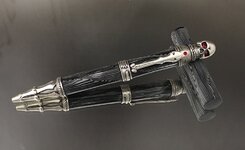Carl and Jim, thank you both!
For those of you that have never heard of galalith, here's a little write-up I found:
"Casein, the protein in milk was used by the Ancient Egyptians as a fixative for pigments in wall paintings. It has also been used as a constituent in various glues but it appears not to have been used as the basis of a solid plastics material until the end of the 19th century. Krisch, head of a large firm of printers in Hanover experimented with casein to make a washable white board for replacing the slates used in school - paper was too expensive at that time for use by children to practice writing. He collaborated with Adolf Spitteler, a chemist in Bavaria and on July 15th 1899, a patent for "plastic compositions" was taken out in Germany.
The patent was taken up by firms in Germany (Vereinigten Gummivarenfabriken, at its factory in Harburg) and in France by Pellerin and Orosdi (Compagnie Francaise de la Galalithe, at Levallois Perret). The product was introduced under the trade name Galalith and was first shown at the Paris Universal Exhibition in 1900. A lot of development work was still required to produce a stable material, and the two companies merged in 1904 to form the International Galalith Gesellschaft Hoff and Company with a new factory in Harburg. A process starting with dried casein granules, known as the dry process, was developed and this was to become the universally adopted method for casein plastics manufacture and remained virtually unchanged throughout its history."
Have a great weekend everyone!

